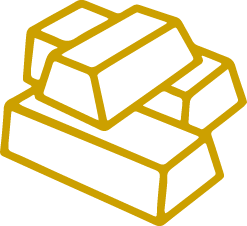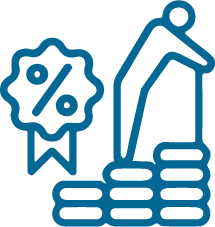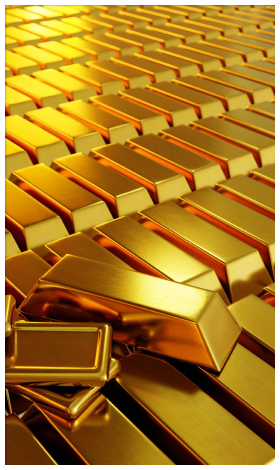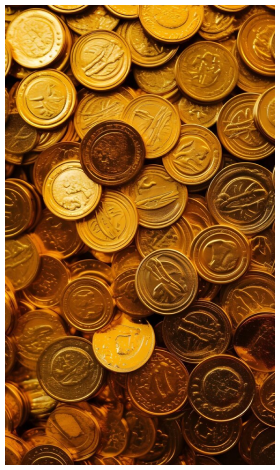Chicago Precious Metals
CP
Chicago Precious Metals
CP
Chicago Precious Metals
CP
Chicago Precious Metals
CP
CPM
CPM
CPM
CPM
CPM
metals
exchange
platform
Buy or Sell investment-grade precious metals directly from the Exchange. Chicago Precious Metals of Punta Gorda can help you with storage and/or delivery – not only help you, but do so smoothly and expertly, taking care of all the connective tissue necessary in getting your bullion from the trading screen to you.
Getting Started


choose your independent
custodian
CPME can suggest and independent third
party Custodian if you desire.


choose your precious metal
Decide which precious metals to include in
your IRA. CPME offers a variety of gold and
silver coins and bars that can be held in
IRA's.


complete your self-directed
ira paperwork
Your personal CPME Account Executive
can send the necessary forms or click to
access them.


fund your ira
Fund your IRA with a monetary contribution,
direct transfer from another IRA, or rollover
funds received from another IRA or
retirement plan, such as a 401(k)or 402(b).
Getting Started
Gold & Silver IRA – Get Started in 4 Easy Steps
SELF DIRECTED PRECIOUS METAL IRA
The IRS allows an IRA, Individual 401(k), HSA, or ESA to acquire certain precious metals as an asset without penalty and while keeping the tax benefits associated with that account type.
Acquiring assets, such as silver, platinum, palladium or gold in an IRA is one way to diversify your retirement portfolio. Many people have experience investing their personal funds in precious metals. They are now looking to capitalize on that experience and generate retirement wealth that is tax-deferred or tax-free.
Gold IRA
To salvage the savings acquired for an individual’s retirement, implementing a precious metal IRAs can offer vital assistance. By possessing a gold IRA investment, a person can increase their account’s potential for added benefits. Contrary to paper assets that operate under extreme benefits and losses on the fiscal continuum, gold is relatively static. Having a dependent asset that is void of bipolar dips in economy allows an individual to have more comfort in the fact that they have a reliable and well-balanced portfolio.
SELF DIRECTED PRECIOUS METAL IRA
The IRS allows an IRA, Individual 401(k), HSA, or ESA to acquire certain precious metals as an asset without penalty and while keeping the tax benefits associated with that account type.
Acquiring assets, such as silver, platinum, palladium or gold in an IRA is one way to diversify your retirement portfolio. Many people have experience investing their personal funds in precious metals. They are now looking to capitalize on that experience and generate retirement wealth that is tax-deferred or tax-free.
Silver IRA
In terms of economic circumstances, silver can rise in growth when the economy becomes ambiguous. Silver also has a tendency to rise when predicted inflation and government debt levels increase. Because silver is a pliable asset, it can be applied to many different areas through economic expansion periods. With less downside risk and more upside potential, there is not a justifying reason why anyone should not possess silver or other precious metals IRA.
SELF DIRECTED PRECIOUS METAL IRA
The IRS allows an IRA, Individual 401(k), HSA, or ESA to acquire certain precious metals as an asset without penalty and while keeping the tax benefits associated with that account type.
Acquiring assets, such as silver, platinum, palladium or gold in an IRA is one way to diversify your retirement portfolio. Many people have experience investing their personal funds in precious metals. They are now looking to capitalize on that experience and generate retirement wealth that is tax-deferred or tax-free.
Paltinum IRA
When it comes to investing in precious metals, gold and silver are the most noted assets. What the public fails to see is that platinum and palladium are the infamous underdogs—but maybe not for long. As more investors and specialists are discovering, investing in platinum and palladium are increasing in popularity among the masses. Individual retirement arrangements, or IRAs, are to secure and congratulate an individual’s life of hard work.



Investment Guide
THE HISTORY OF GOLD & SILVER
Gold and silver are one of the oldest forms of currency in the world. These two precious metals have been known to circulate as tradable money for thousands of years. This is a trait that no other printed money can even come close to matching. If you ever wonder why some people say that gold and silver are the most enduring investment vehicle in the world, you can attribute as much to the fact that they have been around as long as money itself.
JEWELRY, CURRENCY, & COMMON USAGE
Aside from jewelry and currency, investments and industrial use are the other two primary functions of gold and silver. The value in metals traces back to its use as currency, while the industrial usage can be attributed to its soft, conductive qualities. Though you might not realize it, metals are frequently used in the production of everything from electronics to vehicles.
GOLD STANDARD & GOVERNMENT
The Gold Standard is a term that many are familiar with. When a government is using the Gold Standard, it means that they are basing their currency and valuations on a worth equal to an amount in precious metals (namely gold and silver). The United States is one of the most notorious countries that had once used the gold standard.
PURITY IN GOLD & SILVER
When it comes to investing and buying gold and silver, you will almost always be dealing with the most pure forms. Aside from coins which are produced with varied amounts of silver and gold content, almost all bars for both gold and silver are at least 99.9% pure. Purity is also represented in numerical form, commonly as .999 (99.9%) or .9999 (99.99%) gold or silver.
Who we are
Chicago Precious Metals of Punta Gorda is a metals exchange platform providing individuals and institutions the ability to buy and sell physical precious metals with an advisory arm specializing in client ownership of physical precious metals within their retirement accounts.

People
Along with our reputation, our people are our most valued asset. We believe no barrier should inhibit an individual from performing to his or her full potential.

Diversity
Chicago Precious Metals of Punta Gorda is the Midwest’s leading precious metals exchange and a fast-growing force within the precious metals sector. We are currently selling to a hugely diverse range of clients – from local individuals to major regional, national, and international corporations.

People
Our values are reflected in the way that we conduct our business and in the results that we consistently achieve for our clients.

the leading authority on precious metals
From the broadcast selection to collaborative client relationships and unmatched numismatic expertise, Chicago Precious Metals of Punta Gorda is your top choice for wisely investing in precious metals and rare coins.

unmatched industry & market expertise
Chicago Precious Metals of Punta Gorda continues to lead with some of the industry's most talented and experienced team of precious metals and numismatic experts.

advisors you can trust to do the right thing
We stake our business on being honest open and forthright with every client, and we take pride in our reputation for integrity.

driven by your long-term success
There are no single transactions here. With our consultative approach to service, we aim to develop long-term relationships that help you achieve sustained financial success.
frequently ASKED QUESTIONS
How do I change my account information?
Address change – Send a letter including old address, new address, account number, and signature.
Title or Name Change – The person removing their name must send a letter instructing Chicago Precious Metals of Punta Gorda to remove their name. A new Account Opening Form must be completed by the remaining party(s) on the account.
Death – When an account holder dies, please provide Chicago Precious Metals of Punta Gorda with a certified copy of the death certificate, Letters of Testamentary or Administration, a letter of instruction, and a new Account Opening Form to update the account.
I represent a financial institution, why should I add precious metals to my company’s product mix?
3% to 5% of Americans invest in precious metals.
69% of precious metals investors want to buy from their established financial institution, yet only 21% actually do.
Banks and brokerage firms that offer precious metals investments attract approximately 70% of their precious metals clients from other financial institutions.
Precious metals investors tend to be affluent and well-educated.
Demand for precious metals investment products, such as gold, silver, platinum, and palladium bullion, has increased dramatically over the years. While only a few thousand Americans had invested in precious metals in 1975 when gold ownership was legalized in the U.S., that number has grown substantially. Independent research shows that 7.5 to 12.5 million Americans now invest in precious metals; these investors are generally college-educated professionals with above-average incomes. The same research indicates that individuals who have purchased precious metals, as well as those who plan to do so in the future, prefer to make these purchases from their bank or other trusted financial institution.
Precious metals services help brokerage firms retain and enhance customer relationships.
Precious metals services generate fee income.
Precious metals services can be offered with no risk and little or no investment in support activities.
Precious metals services provided in Delaware may have significant tax advantages.
Chicago Precious Metals of Punta Gorda offers its correspondent institutions many concrete benefits. First, and perhaps most important, Chicago Precious Metals of Punta Gorda enables correspondents to meet customer demand for precious metals services and broaden the relationships now enjoyed with existing customers. By expanding the array of investment services to include precious metals, correspondents reduce the possibility of losing assets and customers to competing full-service institutions. At the same time, precious metals services provide a source of transaction fees. Chicago Precious Metals of Punta Gorda’s services can be offered through existing retail, brokerage, trust, and private banking departments with virtually no risk and little or no investment. It requires no direct handling of precious metals products, no maintenance of physical inventories, and no additional staff. Chicago Precious Metals of Punta Gorda offers total marketing, trading, and operational support.
Is it better to purchase buy large bars or small bars and coins?
There is no single answer to this question.
Large bars (100-ounce gold, 1,000-ounce silver, 50-ounce platinum or 100-ounce palladium bars) generally have lower premiums and smaller bid/ask spreads, thereby making them the lowest cost alternative when buying. However, they require a larger investment and can only be liquidated in large units. Delivery can be burdensome and redelivery for liquidation may require assay and refining. Storage costs must be factored into the decision.
Small bullion bars and coins generally have higher premiums and larger bid/ask spreads than larger bars. However, they can be bought and sold in small unit sizes, are easily shipped, and typically do not require assay when redelivered for liquidation. They can be easily stored in a commercial vault or safe deposit box.
Where is my metal held in custody?
Chicago Precious Metals of Punta Gorda primarily utilizes the custody services of Delaware Depository. Located in Wilmington, DE, Delaware Depository is an exchange-approved depository.
What makes precious metals “precious”?
Gold, silver, platinum and palladium possess six innate attributes that render them unique in all of nature. They are Beauty, Utility, Rarity, Indestructibility, Portability, and Inherent Value.
No other elements known to man manifest all the characteristics, and it is for this reason that mankind has always considered these metals precious.
Why are the prices quoted for precious metals by dealers different than the prices listed in the newspaper?
Most newspapers either show the previous day’s prices from the New York commodity exchanges or London market. The New York prices are for the standardized futures contract, closest to maturity (i.e., the nearby delivery month) on the close of exchange business. The London prices are for the “fixing” prices set by the world’s largest market makers to balance their books. Both New York and London prices provide a good benchmark for the value of gold (or silver, or platinum or palladium). However, the prices reflect a very specific set of product specifications, terms and trading counterparties; they do not represent the price of metals in any quantity, form, location or trading forum. Consequently, dealers monitor the New York and London prices to determine a starting price point from which they can determine a competitive final price for a particular transaction. The dealer quotes the current spot price at that particular moment in time or a quote for a specific product where the cost of that product includes manufacturing costs, and supply and demand premiums. That quote may also include delivery, insurance, and sales charges.
What are the differences between bullion coins and rare or “numismatic” coins?
Bullion coins are produced in mass quantities by government mints and are legal tender in their country of origin. Bullion coins sell for a small premium over their intrinsic (or spot) metal value. Bullion coin prices move, in tandem, with the price fluctuations of the underlying commodity (i.e., gold, silver, platinum or palladium).
Rare or “numismatic” coins are collected and valued for their scarcity, individual beauty, uniqueness or historical significance. Special collectible qualities can potentially render rare coins far more valuable in the marketplace than the value of any gold or silver that they may contain.
What is meant by the “fineness” or “purity” of precious metals?
The purity of precious metal is measured in parts per thousand and is called its “fineness.” This indicates the proportion of pure precious metal actually contained in the refined product verses its remaining alloys. A bar that is 999.9 fine is 99.99% pure gold and referred to as “four nines” gold.
Why should I invest in precious metals?
Investors have many different motivations and objectives when considering an investment in precious metals.
Precious metals:
-are tangible/real assets
-their value is not determined by any government or company
-are excellent portfolio diversifiers
-inclusion of precious metals in an investment portfolio can
-reduce overall volatility and risk
-serve as a hedge against inflation in times of economic uncertainty
-provide a store of long-term value – they have intrinsic value
-provide a safe haven in times of political or international unrest
-are an alternative asset with price appreciation potential
| Contract ID | Symbol | Expiration | Strike | Type | Last Price | Change | Bid | Ask | Volume | Open Interest |
|---|---|---|---|---|---|---|---|---|---|---|
| XXYYZZ999999C00020000 | XXYYZZ | 2099-99-99 | 20.00 | call | 100.00 | ▲ 0.099999999999994 | 100.05 | 100.15 | 100 | 100 |
| XXYYZZ999999P00020000 | XXYYZZ | 2099-99-99 | 20.00 | put | 100.00 | ▲ 0.099999999999994 | 100.05 | 100.15 | 100 | 100 |
| XXYYZZ999999C00030000 | XXYYZZ | 2099-99-99 | 30.00 | call | 100.00 | ▲ 0.099999999999994 | 100.05 | 100.15 | 100 | 100 |
| XXYYZZ999999P00030000 | XXYYZZ | 2099-99-99 | 30.00 | put | 100.00 | ▲ 0.099999999999994 | 100.05 | 100.15 | 100 | 100 |




